Shengxiang Yang
Center for Computational Intelligence
Nearest-Better Network for Visualizing and Analyzing Combinatorial Optimization Problems: A Unified Tool
Jul 30, 2025Abstract:The Nearest-Better Network (NBN) is a powerful method to visualize sampled data for continuous optimization problems while preserving multiple landscape features. However, the calculation of NBN is very time-consuming, and the extension of the method to combinatorial optimization problems is challenging but very important for analyzing the algorithm's behavior. This paper provides a straightforward theoretical derivation showing that the NBN network essentially functions as the maximum probability transition network for algorithms. This paper also presents an efficient NBN computation method with logarithmic linear time complexity to address the time-consuming issue. By applying this efficient NBN algorithm to the OneMax problem and the Traveling Salesman Problem (TSP), we have made several remarkable discoveries for the first time: The fitness landscape of OneMax exhibits neutrality, ruggedness, and modality features. The primary challenges of TSP problems are ruggedness, modality, and deception. Two state-of-the-art TSP algorithms (i.e., EAX and LKH) have limitations when addressing challenges related to modality and deception, respectively. LKH, based on local search operators, fails when there are deceptive solutions near global optima. EAX, which is based on a single population, can efficiently maintain diversity. However, when multiple attraction basins exist, EAX retains individuals within multiple basins simultaneously, reducing inter-basin interaction efficiency and leading to algorithm's stagnation.
An Evolutionary Network Architecture Search Framework with Adaptive Multimodal Fusion for Hand Gesture Recognition
Mar 27, 2024Abstract:Hand gesture recognition (HGR) based on multimodal data has attracted considerable attention owing to its great potential in applications. Various manually designed multimodal deep networks have performed well in multimodal HGR (MHGR), but most of existing algorithms require a lot of expert experience and time-consuming manual trials. To address these issues, we propose an evolutionary network architecture search framework with the adaptive multimodel fusion (AMF-ENAS). Specifically, we design an encoding space that simultaneously considers fusion positions and ratios of the multimodal data, allowing for the automatic construction of multimodal networks with different architectures through decoding. Additionally, we consider three input streams corresponding to intra-modal surface electromyography (sEMG), intra-modal accelerometer (ACC), and inter-modal sEMG-ACC. To automatically adapt to various datasets, the ENAS framework is designed to automatically search a MHGR network with appropriate fusion positions and ratios. To the best of our knowledge, this is the first time that ENAS has been utilized in MHGR to tackle issues related to the fusion position and ratio of multimodal data. Experimental results demonstrate that AMF-ENAS achieves state-of-the-art performance on the Ninapro DB2, DB3, and DB7 datasets.
Benchmark for CEC 2024 Competition on Multiparty Multiobjective Optimization
Feb 03, 2024Abstract:The competition focuses on Multiparty Multiobjective Optimization Problems (MPMOPs), where multiple decision makers have conflicting objectives, as seen in applications like UAV path planning. Despite their importance, MPMOPs remain understudied in comparison to conventional multiobjective optimization. The competition aims to address this gap by encouraging researchers to explore tailored modeling approaches. The test suite comprises two parts: problems with common Pareto optimal solutions and Biparty Multiobjective UAV Path Planning (BPMO-UAVPP) problems with unknown solutions. Optimization algorithms for the first part are evaluated using Multiparty Inverted Generational Distance (MPIGD), and the second part is evaluated using Multiparty Hypervolume (MPHV) metrics. The average algorithm ranking across all problems serves as a performance benchmark.
An Evolving Population Approach to Data-Stream Classification with Extreme Verification Latency
Dec 07, 2023Abstract:Recognising and reacting to change in non-stationary data-streams is a challenging task. The majority of research in this area assumes that the true class label of incoming points are available, either at each time step or intermittently with some latency. In the worse case this latency approaches infinity and we can assume that no labels are available beyond the initial training set. When change is expected and no further training labels are provided the challenge of maintaining a high classification accuracy is very great. The challenge is to propagate the original training information through several timesteps, possibly indefinitely, while adapting to underlying change in the data-stream. In this paper we conduct an initial study into the effectiveness of using an evolving, population-based approach as the mechanism for adapting to change. An ensemble of one-class-classifiers is maintained for each class. Each classifier is considered as an agent in the sub-population and is subject to selection pressure to find interesting areas of the feature space. This selection pressure forces the ensemble to adapt to the underlying change in the data-stream.
Vector Autoregressive Evolution for Dynamic Multi-Objective Optimisation
May 22, 2023



Abstract:Dynamic multi-objective optimisation (DMO) handles optimisation problems with multiple (often conflicting) objectives in varying environments. Such problems pose various challenges to evolutionary algorithms, which have popularly been used to solve complex optimisation problems, due to their dynamic nature and resource restrictions in changing environments. This paper proposes vector autoregressive evolution (VARE) consisting of vector autoregression (VAR) and environment-aware hypermutation to address environmental changes in DMO. VARE builds a VAR model that considers mutual relationship between decision variables to effectively predict the moving solutions in dynamic environments. Additionally, VARE introduces EAH to address the blindness of existing hypermutation strategies in increasing population diversity in dynamic scenarios where predictive approaches are unsuitable. A seamless integration of VAR and EAH in an environment-adaptive manner makes VARE effective to handle a wide range of dynamic environments and competitive with several popular DMO algorithms, as demonstrated in extensive experimental studies. Specially, the proposed algorithm is computationally 50 times faster than two widely-used algorithms (i.e., TrDMOEA and MOEA/D-SVR) while producing significantly better results.
Semi-supervised Deep Learning for Image Classification with Distribution Mismatch: A Survey
Mar 10, 2022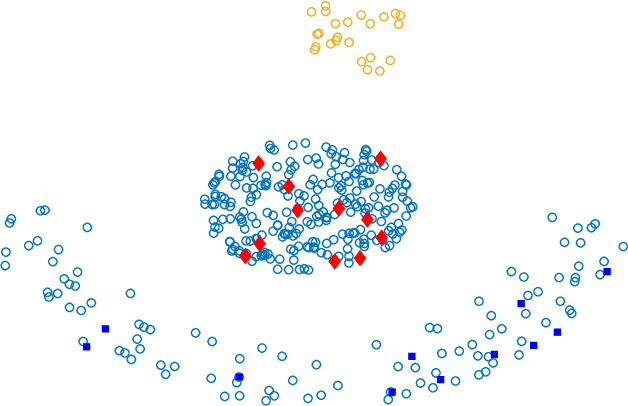
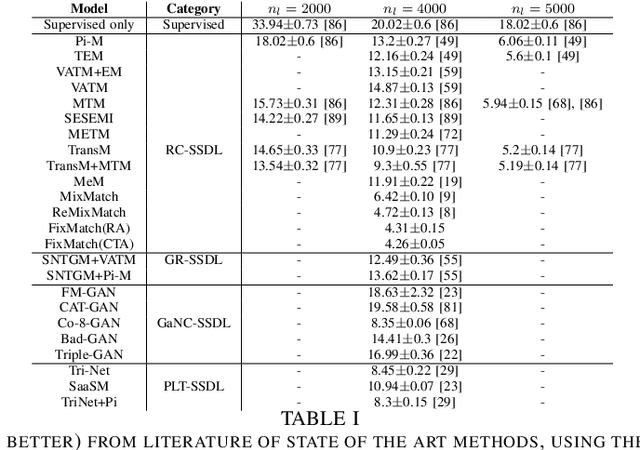
Abstract:Deep learning methodologies have been employed in several different fields, with an outstanding success in image recognition applications, such as material quality control, medical imaging, autonomous driving, etc. Deep learning models rely on the abundance of labelled observations to train a prospective model. These models are composed of millions of parameters to estimate, increasing the need of more training observations. Frequently it is expensive to gather labelled observations of data, making the usage of deep learning models not ideal, as the model might over-fit data. In a semi-supervised setting, unlabelled data is used to improve the levels of accuracy and generalization of a model with small labelled datasets. Nevertheless, in many situations different unlabelled data sources might be available. This raises the risk of a significant distribution mismatch between the labelled and unlabelled datasets. Such phenomena can cause a considerable performance hit to typical semi-supervised deep learning frameworks, which often assume that both labelled and unlabelled datasets are drawn from similar distributions. Therefore, in this paper we study the latest approaches for semi-supervised deep learning for image recognition. Emphasis is made in semi-supervised deep learning models designed to deal with a distribution mismatch between the labelled and unlabelled datasets. We address open challenges with the aim to encourage the community to tackle them, and overcome the high data demand of traditional deep learning pipelines under real-world usage settings.
Benchmark Functions for CEC 2022 Competition on Seeking Multiple Optima in Dynamic Environments
Jan 06, 2022



Abstract:Dynamic and multimodal features are two important properties and widely existed in many real-world optimization problems. The former illustrates that the objectives and/or constraints of the problems change over time, while the latter means there is more than one optimal solution (sometimes including the accepted local solutions) in each environment. The dynamic multimodal optimization problems (DMMOPs) have both of these characteristics, which have been studied in the field of evolutionary computation and swarm intelligence for years, and attract more and more attention. Solving such problems requires optimization algorithms to simultaneously track multiple optima in the changing environments. So that the decision makers can pick out one optimal solution in each environment according to their experiences and preferences, or quickly turn to other solutions when the current one cannot work well. This is very helpful for the decision makers, especially when facing changing environments. In this competition, a test suit about DMMOPs is given, which models the real-world applications. Specifically, this test suit adopts 8 multimodal functions and 8 change modes to construct 24 typical dynamic multimodal optimization problems. Meanwhile, the metric is also given to measure the algorithm performance, which considers the average number of optimal solutions found in all environments. This competition will be very helpful to promote the development of dynamic multimodal optimization algorithms.
Dealing with Distribution Mismatch in Semi-supervised Deep Learning for Covid-19 Detection Using Chest X-ray Images: A Novel Approach Using Feature Densities
Aug 17, 2021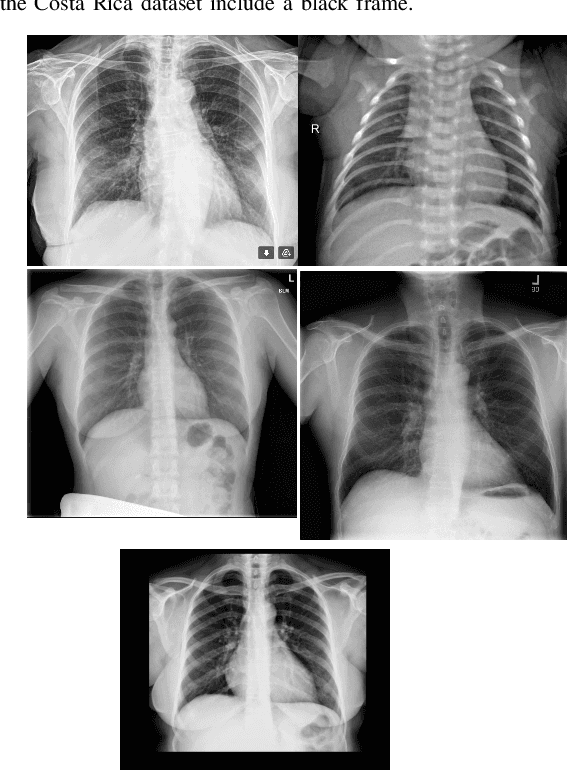

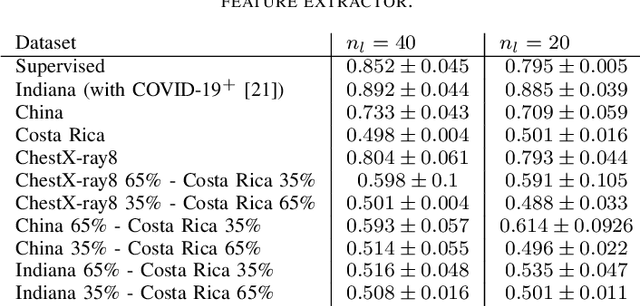

Abstract:In the context of the global coronavirus pandemic, different deep learning solutions for infected subject detection using chest X-ray images have been proposed. However, deep learning models usually need large labelled datasets to be effective. Semi-supervised deep learning is an attractive alternative, where unlabelled data is leveraged to improve the overall model's accuracy. However, in real-world usage settings, an unlabelled dataset might present a different distribution than the labelled dataset (i.e. the labelled dataset was sampled from a target clinic and the unlabelled dataset from a source clinic). This results in a distribution mismatch between the unlabelled and labelled datasets. In this work, we assess the impact of the distribution mismatch between the labelled and the unlabelled datasets, for a semi-supervised model trained with chest X-ray images, for COVID-19 detection. Under strong distribution mismatch conditions, we found an accuracy hit of almost 30\%, suggesting that the unlabelled dataset distribution has a strong influence in the behaviour of the model. Therefore, we propose a straightforward approach to diminish the impact of such distribution mismatch. Our proposed method uses a density approximation of the feature space. It is built upon the target dataset to filter out the observations in the source unlabelled dataset that might harm the accuracy of the semi-supervised model. It assumes that a small labelled source dataset is available together with a larger source unlabelled dataset. Our proposed method does not require any model training, it is simple and computationally cheap. We compare our proposed method against two popular state of the art out-of-distribution data detectors, which are also cheap and simple to implement. In our tests, our method yielded accuracy gains of up to 32\%, when compared to the previous state of the art methods.
A Real Use Case of Semi-Supervised Learning for Mammogram Classification in a Local Clinic of Costa Rica
Jul 24, 2021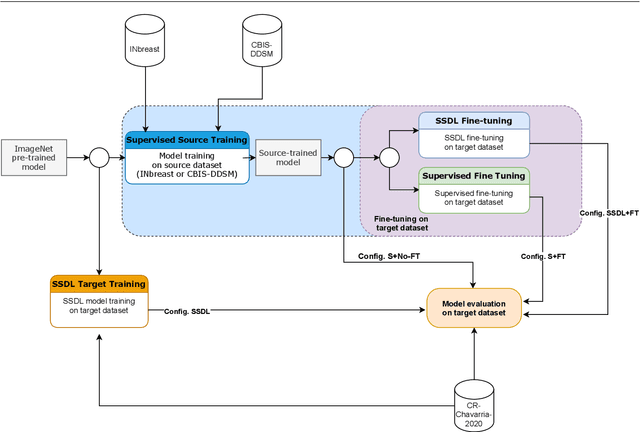
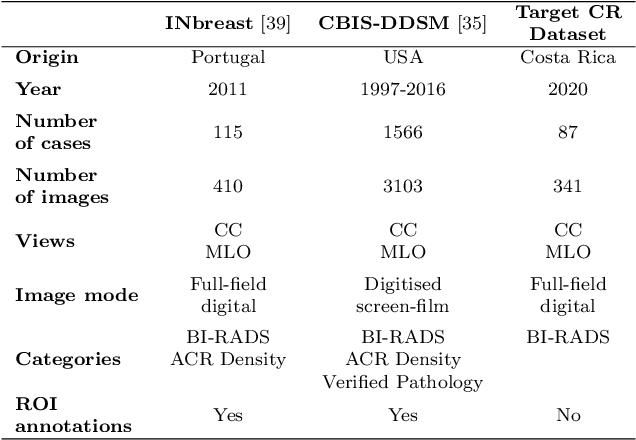
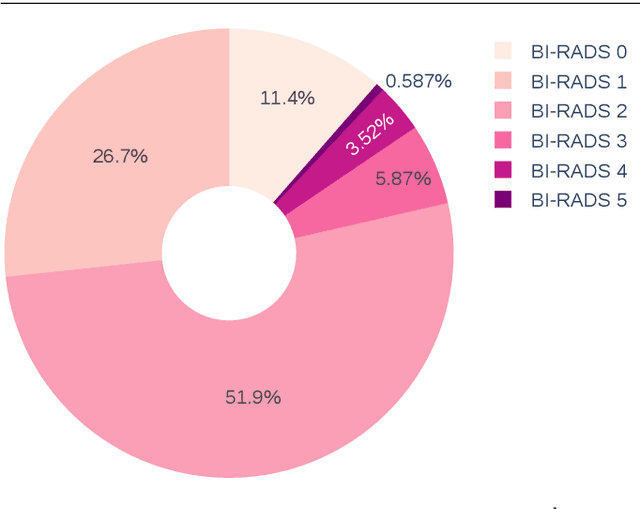
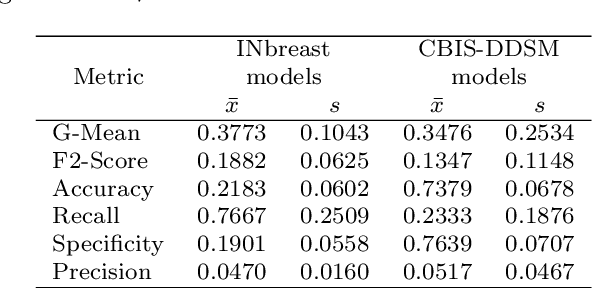
Abstract:The implementation of deep learning based computer aided diagnosis systems for the classification of mammogram images can help in improving the accuracy, reliability, and cost of diagnosing patients. However, training a deep learning model requires a considerable amount of labeled images, which can be expensive to obtain as time and effort from clinical practitioners is required. A number of publicly available datasets have been built with data from different hospitals and clinics. However, using models trained on these datasets for later work on images sampled from a different hospital or clinic might result in lower performance. This is due to the distribution mismatch of the datasets, which include different patient populations and image acquisition protocols. The scarcity of labeled data can also bring a challenge towards the application of transfer learning with models trained using these source datasets. In this work, a real world scenario is evaluated where a novel target dataset sampled from a private Costa Rican clinic is used, with few labels and heavily imbalanced data. The use of two popular and publicly available datasets (INbreast and CBIS-DDSM) as source data, to train and test the models on the novel target dataset, is evaluated. The use of the semi-supervised deep learning approach known as MixMatch, to leverage the usage of unlabeled data from the target dataset, is proposed and evaluated. In the tests, the performance of models is extensively measured, using different metrics to assess the performance of a classifier under heavy data imbalance conditions. It is shown that the use of semi-supervised deep learning combined with fine-tuning can provide a meaningful advantage when using scarce labeled observations. We make available the novel dataset for the benefit of the community.
Generating Large-scale Dynamic Optimization Problem Instances Using the Generalized Moving Peaks Benchmark
Jul 23, 2021



Abstract:This document describes the generalized moving peaks benchmark (GMPB) and how it can be used to generate problem instances for continuous large-scale dynamic optimization problems. It presents a set of 15 benchmark problems, the relevant source code, and a performance indicator, designed for comparative studies and competitions in large-scale dynamic optimization. Although its primary purpose is to provide a coherent basis for running competitions, its generality allows the interested reader to use this document as a guide to design customized problem instances to investigate issues beyond the scope of the presented benchmark suite. To this end, we explain the modular structure of the GMPB and how its constituents can be assembled to form problem instances with a variety of controllable characteristics ranging from unimodal to highly multimodal, symmetric to highly asymmetric, smooth to highly irregular, and various degrees of variable interaction and ill-conditioning.
 Add to Chrome
Add to Chrome Add to Firefox
Add to Firefox Add to Edge
Add to Edge